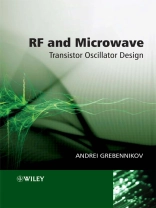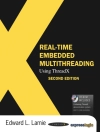The increase of consumer electronics and communications
applications using Radio Frequency (RF) and microwave circuits has
implications for oscillator design. Applications working at higher
frequencies and using novel technologies have led to a demand for
more robust circuits with higher performance and functionality, but
decreased costs, size and power consumption. As a result, there is
also a need for more efficient oscillators.
This book presents up to date information on all aspects of
oscillator design, enabling a selection of the best oscillator
topologies with optimized noise reduction and electrical
performance. RF and Microwave Transistor Oscillator Design
covers:
* analyses of non-linear circuit design methods including
spectral-domain analysis, time-domain analysis and the quasilinear
method;
* information on noise in oscillators including chapters on
varactor and oscillator frequency tuning, CMOS voltage-controlled
oscillators and wideband voltage-controlled oscillators;
* information on the stability of oscillations, with discussions
on the stability of multi-resonant circuits and the phase plane
method;
* optimized design and circuit techniques, beginning with the
empirical and analytic design approaches, moving on to the
high-efficiency design technique;
* general operation and design principles of oscillators,
including a section on the historical aspects of oscillator
configurations.
A valuable reference for practising RF and Microwave designers
and engineers, RF and Microwave Transistor Oscillator Design
is also useful for lecturers, advanced students and research and
design (R&D) personnel.
Inhaltsverzeichnis
About the Author.
Preface.
Acknowledgements.
1 Nonlinear circuit design methods.
1.1 Spectral-domain analysis.
1.2 Time-domain analysis.
1.3 Newton-Raphson algorithm.
1.4 Quasilinear method.
1.5 Van der Pol method.
1.6 Computer-aided analysis and design.
References.
2 Oscillator operation and design principles.
2.1 Steady-state operation mode.
2.2 Start-up conditions.
2.3 Oscillator configurations and historical aspects.
2.4 Self-bias condition.
2.5 Oscillator analysis using matrix techniques.
2.6 Dual transistor oscillators.
2.7 Transmission-line oscillator.
2.8 Push-push oscillator.
2.9 Triple-push oscillator.
2.10 Oscillator with delay line.
References.
3 Stability of self-oscillations.
3.1 Negative-resistance oscillator circuits.
3.2 General single-frequency stability condition.
3.3 Single-resonant circuit oscillators.
3.4 Double-resonant circuit oscillator.
3.5 Stability of multi-resonant circuits.
3.6 Phase plane method.
3.7 Nyquist stability criterion.
3.8 Start-up and stability.
References.
4 Optimum design and circuit technique.
4.1 Empirical optimum design approach.
4.2 Analytic optimum design approach.
4.3 Parallel feedback oscillators.
4.4 Series feedback bipolar oscillators.
4.5 Series feedback MESFET oscillators.
4.6 High-efficiency design technique.
4.7 Practical oscillator schematics.
References.
5 Noise in oscillators.
5.1 Noise figure.
5.2 Flicker noise.
5.3 Active device noise modelling.
5.4 Oscillator noise spectrum: linear model.
5.5 Oscillator noise spectrum: nonlinear model.
5.6 Loaded quality factor.
5.7 Amplitude-to-phase conversion.
5.8 Oscillator pulling figure.
References.
6 Varactor and oscillator frequency tuning.
6.1 Varactor modelling.
6.2 Varactor nonlinearity.
6.3 Frequency modulation.
6.4 Anti-series varactor pair.
6.5 Tuning linearity.
6.6 Reactance compensation technique.
6.7 Practical VCO schematics.
References.
7 CMOS voltage-controlled oscillators.
7.1 MOS varactor.
7.2 Phase noise.
7.3 Flicker noise.
7.4 Tank inductor.
7.5 Circuit design concepts and technique.
7.6 Implementation technology issues.
7.7 Practical schematics of CMOS VCOs.
References.
8 Wideband voltage-controlled oscillators.
8.1 Main requirements.
8.2 Single-resonant circuits with lumped elements.
8.3 Double-resonant circuit with lumped elements.
8.4 Transmission line circuit realization.
8.5 VCO circuit design aspects.
8.6 Wideband nonlinear design.
8.7 Dual mode varactor tuning.
8.8 Practical RF and microwave wideband VCOs.
References.
9 Noise reduction techniques.
9.1 Resonant circuit design technique.
9.2 Low-frequency loading and feedback optimization.
9.3 Filtering technique.
9.4 Noise-shifting technique.
9.5 Impedance noise matching.
9.6 Nonlinear feedback loop noise suppression.
References.
Index.
Über den Autor
Andrei Grebennikov is a senior member if IEEE. His scientific and engineering activity includes the design and development of RF and microwave power amplifiers for different powers and bandwidths, single-frequency and voltage-controlled oscillators, modulators, mixers and multipliers using any types of bipolar and field-effect transistors. In addition to this, Andrei has experience reading lectures and classes in microwave & RF engineering as well as training and technical presentations for RF design engineers.












